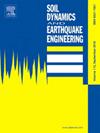Seismic performance of wheat-silo-pile-soil interaction system implemented by a time staggered coupling of FEM and BEM
IF 4.2
2区 工程技术
Q1 ENGINEERING, GEOLOGICAL
引用次数: 0
Abstract
The response of a column-supported wheat silo to earthquake ground motions is complicated by the nonlinear behaviour of the silo-column structure and the interaction of the pile-soil system. A three-dimensional dynamic wheat-silo-pile-soil (WSPS) interaction modelling framework is developed using a novel and highly efficient time staggered coupling of FEM and time-domain BEM (TD-BEM) methods. Based on the time staggered coupling approach, the entire WSPS interaction system is divided into two sub-systems of wheat-silo-pile and soil. The nonlinear behaviours of wheat-silo-pile sub-system are simulated by the FEM, while the TD-BEM excels in accurately modelling seismic wave propagation in the soil sub-system with infinite extension. The key advantage of the presented time staggered coupling method lies in achieving significant computational efficiency by addressing the challenge of different time steps required for the wheat-silo-pile and soil sub-systems. Notably, this time staggered coupling method promotes efficient computation of complex multibody dynamic systems by separately solving the system equations of the FEM and TD-BEM at different time instants. Using the constructed WSPS modelling system, the interaction effects between the wheat-silo sub-system and the foundation under seismic actions are investigated. Furthermore, comparing to traditional dynamic analysis systems for wheat silos, the characteristic responses of WSPS systems in different silo filling states and with different pile sections are examined. Results indicated that there is considerable scope of balancing the stiffness and the selection of pile types in the seismic design of silos in soft soil regions to improve the seismic performance of the WSPS systems.
小麦-筒仓-桩-土相互作用体系的有限元与边界元交错耦合分析
由于筒仓-柱结构的非线性特性和桩-土体系的相互作用,使得柱式小麦筒仓对地震地震动的响应变得复杂。采用一种新颖、高效的时间交错耦合有限元法和时域边界元法(TD-BEM),建立了小麦-筒仓-桩-土(WSPS)三维动态相互作用模型框架。基于时间交错耦合方法,将整个WSPS相互作用系统划分为小麦-筒仓桩和土壤两个子系统。采用有限元法对小麦-筒仓-桩体系的非线性行为进行了模拟,而TD-BEM法能较准确地模拟地震波在无限延伸的土体系中的传播。所提出的时间交错耦合方法的关键优势在于,通过解决小麦-筒仓-桩和土壤子系统所需的不同时间步长的挑战,实现了显著的计算效率。值得注意的是,这种时间交错耦合方法通过在不同时刻分别求解FEM和TD-BEM的系统方程,提高了复杂多体动力系统的计算效率。利用构建的WSPS模型系统,研究了地震作用下小麦筒仓子系统与地基的相互作用效应。此外,与传统的小麦筒仓动力分析系统相比,研究了不同筒仓充填状态和不同桩截面下WSPS系统的特征响应。结果表明,在软土地基地区的筒仓抗震设计中,平衡刚度和桩型选择对于提高WSPS系统的抗震性能有较大的余地。
本文章由计算机程序翻译,如有差异,请以英文原文为准。
求助全文
约1分钟内获得全文
求助全文
来源期刊

Soil Dynamics and Earthquake Engineering
工程技术-地球科学综合
CiteScore
7.50
自引率
15.00%
发文量
446
审稿时长
8 months
期刊介绍:
The journal aims to encourage and enhance the role of mechanics and other disciplines as they relate to earthquake engineering by providing opportunities for the publication of the work of applied mathematicians, engineers and other applied scientists involved in solving problems closely related to the field of earthquake engineering and geotechnical earthquake engineering.
Emphasis is placed on new concepts and techniques, but case histories will also be published if they enhance the presentation and understanding of new technical concepts.
 求助内容:
求助内容: 应助结果提醒方式:
应助结果提醒方式:


